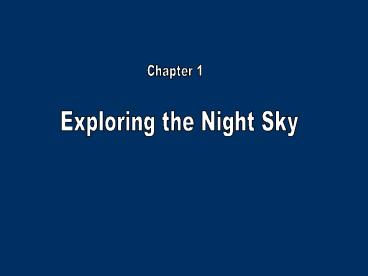Exploring the Night Sky PowerPoint PPT Presentation
1 / 31
Title: Exploring the Night Sky
1
Chapter 1
Exploring the Night Sky
2
What can you see in the night sky?
stars
the moon
What else?
3
Star patterns in the sky
constellations
a group of stars that forms a pattern in the
night sky.
4
How many constellations do astronomers
recognize?
8
8
5
How did the constellations get their names?
Northern Hemisphere Greek and
Roman mythology (Leo, Pisces, Taurus, Orion,
Cassiopeia)
Southern Hemisphere animals,
objects explorers encountered and the instruments
they used (Tucana, Ursa Major, Ursa Minor, and
Polaris)
6
What about the Big Dipper?
The Big Dipper is easily seen in the night sky.
It is part of a larger constellation called
Ursa Major or Big Bear
7
The Little Dipper is part of
Ursa Minor or Little Bear
8
Polaris
the North Star is the star at the tip of the
Little Dipper's handle
Almost always exactly above the North Pole
9
constellations
- provide us with a map of the sky
- divide the sky up into 88 imaginary sections
- help astronomers locate objects in the night sky
10
Why do the stars appear to move?
The apparent motion of the stars has to do with
two kinds of movement 1. Earths
rotation 2. Earths revolution
11
Remember
Earth rotates on its axis
12
Earth's
rotation
- takes 24 hours
- counterclockwise
- makes the sun appear to rise in the east and set
in the west - makes the stars appear to move each night from
east to west
13
Earth's
revolution
- takes 365 days (1 year)
- around the sun
- creates the seasons
- means that different stars appear in the sky at
different times of the year
14
Wanderers in the Night Sky
There are objects in the night sky that appear to
act different than the other stars, what are they?
?
15
A different sort of "star"
- Have you heard of the
- Morning Star?
- it seems to shine steady (other stars twinkle)
- Through a telescope it looks like a round disk
- It has phases like the moon
- If you watch it for several days, it moves
against the backdrop of the other stars!! - There are 5 of these strange stars
16
What did the ancient Greeks have to say about
these 5 special objects?
17
They called them
"wandering stars"
In English we call them
planets (which is the
Greek word for wanderer)
18
What is the difference between a
and a ?
planet
star
19
star
- huge globe of hot gases
- shines by its own light
- the Sun is a star (it appears bigger because it
is closer to us than the other stars)
20
planet
- large object
- orbits a star
- does not produce light
21
The "morning star"
Is really Venus!!
22
(No Transcript)
23
Telescopes How they work
telescope
A viewing instrument that can magnify distant
objects
24
Where did come from?
telescopes
- Who made it first? Many believe Hans Lippershey
(a Dutch eyeglass maker) - Galileo improved it (he saw Jupiters 4 largest
moons)
25
2 types of telescopes
Refracting (lenses) Reflecting
(mirrors)
1.
2.
26
Largest refracting telescope
At Yerkes Observatory in
Wisconsin 1 meter (39 inches) in diameter
27
largest reflecting telescope
- Mount Palomar, California
- 5 meters (200 inches) in diameter
- The largest telescopes are reflecting because it
is easier to build large mirrors than large
lenses. - a mirror needs only one surface precisely made,
it can be supported underneath. - Light must pass through a lens, so it must be
supported around the edges (it may sag and
distort the image)
28
Telescopes in Space?
- HST (Hubble Space Telescope)
- Beyond the atmosphere (no distorted images)
29
What else is out there?
comets
A small object in space, made of ice, dust, gas,
and rock, that orbits a star and that can form a
gaseous tail.
meteors
Pieces of rock or metal from space that enter
Earths atmosphere. (shooting star) If it lands
on the Earth it is called a meteorite.
30
Comet and meteor facts
- Comets are also called dirty snowballs
- Solar wind causes the comets tail to point away
from the Sun - Halleys Comet is the most famous
- Comets appear to cause many large meteor showers
- Collisions between comets and planets are rare
(did this kill the dinosaurs?) - Meteorites are either metal or rock
- By studying meteorites, scientists can learn
about both comets and the origins of the solar
system.
31
Chapter 1 THE END

